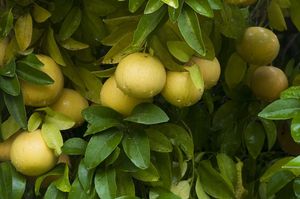Hurricane Dorian’s Impact On Florida Ag Was Minimal
 One day after Hurricane Dorian crept past Florida’s Atlantic coast, impacts to the state’s agricultural and natural resources-based industries appear to be minimal, according to an economist with the University of Florida Institute of Food and Agricultural Sciences.
One day after Hurricane Dorian crept past Florida’s Atlantic coast, impacts to the state’s agricultural and natural resources-based industries appear to be minimal, according to an economist with the University of Florida Institute of Food and Agricultural Sciences.
As of Thursday noon, the most notable effects were minor grapefruit losses in the Indian River area, a consequence of heavy winds that ripped developing fruit from tree branches, said Christa Court, director of the UF/IFAS Economic Impact Analysis Program.
“I’ve received ‘no impact’ reports from seven of Florida’s Atlantic coast counties, which is great news,” said Court, also an assistant professor with the UF/IFAS food and resource economics department. “We’ll have UF/IFAS Extension personnel soliciting reports for several more days, and any producers whose operations were impacted by the hurricane can contact their UF/IFAS Extension county office for help.”
Twelve counties lie along Florida’s Atlantic coast. From south to north, they are: Miami-Dade, Broward, Palm Beach, Martin, St. Lucie, Indian River, Brevard, Volusia, Flagler, St. Johns, Duval and Nassau. Thus far, loss reports have not been communicated to Court regarding Miami-Dade, Broward, Martin and Duval counties. Of the 12, only Palm Beach County has reported losses thus far, to a hydroponic greens operation, she said.
Florida’s east coast grapefruit industry had been considered particularly vulnerable, Court said.
Based primarily in St. Lucie and Indian River counties but also present in Martin, Brevard and Volusia, this sector of Florida citrus production is still recovering from the effects of Hurricane Irma in September 2017 and has struggled with citrus greening disease for nearly 15 years.
Not surprisingly, the area’s growers were hugely relieved to see Dorian bypass them, said Michael Rogers, director of the UF/IFAS Citrus Research and Education Center in Lake Alfred.
“The eye of the hurricane was far enough offshore that the citrus groves in our east coast counties didn’t see much effect except for stiff winds,” Rogers said. “There are about 70,000 acres of citrus in production in the Indian River area, and overall they came through just fine. Our UF/IFAS Extension specialists are ready to assist growers who did suffer fruit drop or other impacts.”
Also at risk were a plethora of Volusia County operations growing ferns and flowers, which are fragile, high-value crops requiring specialized infrastructure. Among all Florida counties, Volusia ranks No. 1 in value of production of its cut-flower and cut-florist greens sector, as well as No. 2 for floriculture and bedding crops, and No. 9 for nursery stock items.
According to Karen Stauderman, UF/IFAS Extension commercial horticulture agent in Volusia County, the fern producers she’d contacted were reporting no losses.
Further north, Duval County officials feared that storm surge along the St. Johns River and its tributaries would have serious impacts on the community but they proved to be minor, Court said. Furthermore, many agricultural enterprises along the state’s First Coast – such as cabbage and potato farms – have not yet planted their winter crop and thus had less reason to fear losses from Dorian.
“We’re assuming that these growers will not see any lingering effects of the storm as they move forward with planting,” Court said. “But if they do, we definitely would like to know about it.”
Court added that UF/IFAS Extension is also interested in hearing from producers who had crop losses stemming from hurricane-preparation efforts.
“Just this morning, I learned about a hydroponic greens operation in Palm Beach County that’s reporting a 100 percent crop loss because they made a decision in late August to partially dismantle their growing system for the sake of protecting the infrastructure investment,” she said. “All of the specialty greens that were growing in the system at the time had to be sacrificed. That’s another type of loss that’s a little less obvious, and we’d like to hear from any other growers who experienced this kind of situation.”
Source: AgFax
